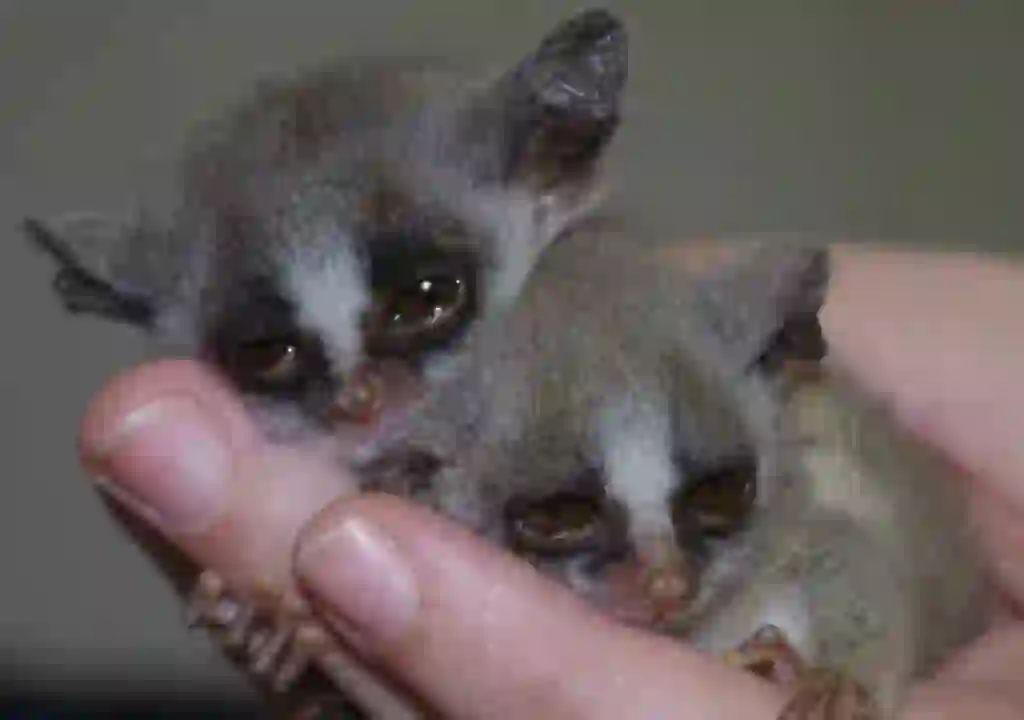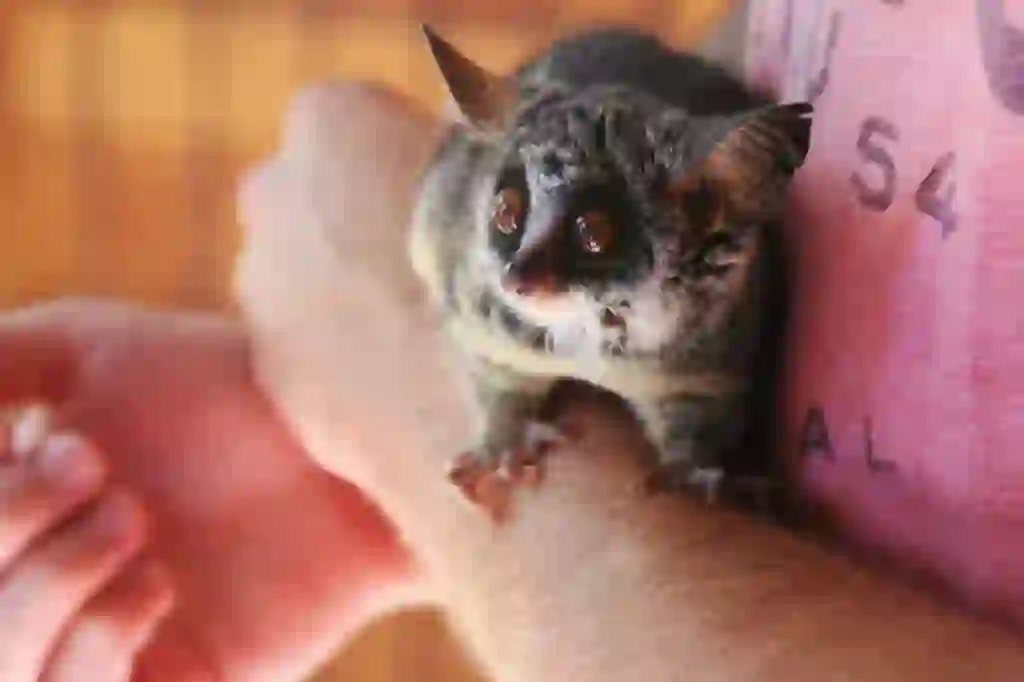
Lesser Galago
Lesser Galago
Lesser Galago
The Lesser Galago, also known as a bushbaby, is among the smallest primates, distinguished by its fluffy fur and large round eyes, and is skilled at burrowing. Not only found in the wild and zoos, Lesser Galagos have recently become popular as pets and are now sold in pet shops as exotic animals. This section introduces their habitats, characteristics, and various charms.
Lesser Galago Basic Infomation

Order: Primates, Family: Galagidae, Genus: Galago
Body length: About 16 cm, Weight: 200-300 g
Among the Galagidae, the Lesser Galago is quite small, about half the size of larger galagos.
Its fur color ranges from silver-gray to a hue close to brown, with short, thick fur that feels soft to the touch.
Each limb has five digits, with long fingers and flat fingertips that allow for a strong grip on tree branches. Its hind limbs alone can support hanging from a branch while lifting its body.
Being entirely nocturnal, it rests in tree holes during the day and becomes active at night to forage for food.
Lesser Galagos do not form groups. Females live with their offspring, while males either live alone or form small groups with other males after breeding.
Males and females have separate territories, which they mark by urinating on trees.
Breeding occurs twice a year, with a gestation period of about two months. Each litter consists of 1-2 young.
Newborns have only half-opened eyes and are not capable of moving independently. Therefore, the mother carries the young in her mouth when moving and leaves them nearby while feeding.
Lesser Galago Q&A

What is the origin of the Lesser Galago's name?
The name 'Lesser Galago' comes from the fact that it is smaller compared to other members of the Galagidae family. In English, they are known as 'Lesser galago', indicating their smaller size. The scientific name is 'Galago senegalensis', where 'Galago' refers to the galago species, and 'senegalensis' implies a connection to Senegal, reflecting their wide distribution across Africa.

Why does the Lesser Galago live there?
The Lesser Galago's habitat ranges from Senegal to Sudan and from Ethiopia to Tanzania across central Africa. They are adaptable to various environments and can be found in densely forested areas, waterside forests, scrublands, and rainforests. Being arboreal, they primarily live in trees.

What does the Lesser Galago eat?
The Lesser Galago is omnivorous. In the wild, they eat insects, small birds, bird eggs, fruits, tree gums, and leaves. As pets, they are typically fed a diet that includes monkey food, supplemented with insects such as mealworms, crickets, and fruits like bananas and apples, as well as boiled sweet potatoes and cooked eggs. Monkey food provides a balanced diet, and additional items like insects and fruits are given as treats.

Is the Lesser Galago skilled at hunting?
The Lesser Galago is an excellent hunter, primarily of insects. They have acute hearing and can distinguish the fluttering sounds of insects, which they capture using their agile movements. Sometimes, they pounce to catch insects in mid-air; other times, they might snatch them silently from surfaces.

What role do the Lesser Galago's large eyes play?
The large eyes of the Lesser Galago are adapted to its nocturnal lifestyle. They possess a reflective layer called the tapetum lucidum, which enhances light and allows them to see clearly in the dark. When light shines into their eyes in the dark, their eyes appear to glow, aiding their vision during nighttime activities.

Can the Lesser Galago move quickly?
Lesser Galagos are very agile and can move quickly between branches in the dark. Their movements are so swift that they are often difficult to follow with the naked eye. On the ground, they can also move quickly, using their strong hind legs to jump great heights, often more than 3 meters. Their typical movement involves bouncing on their hind legs.

Does the Lesser Galago have a cute call?
Known also as 'bush babies', Lesser Galagos are named for their baby-like cries. They emit high-pitched, 'cooing' sounds that resemble the cries of human infants. They also produce various other vocalizations used for alerting to danger or communicating with other galagos. Their vocal range changes depending on their mood, from aggressive or frightened sounds to softer, cooing noises when content or seeking attention.

Where can you see Lesser Galagos in zoos?
In Japan, Lesser Galagos are exhibited in only a few zoos, such as Ueno Zoo in Tokyo, Chiba Zoological Park in Chiba, Japan Monkey Centre in Aichi, Kyoto City Zoo in Kyoto, and Oji Zoo in Hyogo. At Ueno Zoo, they can be observed in the Small Mammal House where their behavior and movement can be closely studied.

Can Lesser Galagos be kept as pets?
Lesser Galagos have recently become available in pet shops as exotic animals. They are among the more challenging exotic pets to care for due to their nocturnal nature and high activity levels at night, which can be problematic in densely populated living areas like apartments. If kept as pets, they require a lot of exercise and a specialized living space. They are adept at jumping and can escape easily if their enclosure is not secure.

What is the personality of the Lesser Galago?
Lesser Galagos are generally quieter compared to other primates but can become aggressive if frightened or disturbed. They are timid and sensitive to loud noises due to their excellent hearing. When their ears are flattened, it's a sign of fear. Creating a quiet, calm environment is crucial for their wellbeing.

What are some considerations for keeping a Lesser Galago?
While Lesser Galagos are not prone to biting unless provoked, their teeth are sharp, and bites can be serious. They carry various bacteria, so any bites should be disinfected immediately. They are also sensitive to cold and do not thrive in damp environments, so maintaining appropriate temperature and humidity levels in their living space is essential. Due to their natural marking behavior, keeping them in a home setting can be challenging without frequent cleaning or using diapers to manage their marking.

What is the lifespan and price of a Lesser Galago?
Lesser Galagos typically live 10 to 15 years. They are rare and expensive due to restrictions on importation and the complexities of breeding them in captivity. Prices in pet shops range from 500,000 to 1,000,000 yen, while animals bred by local breeders might cost between 300,000 to 650,000 yen, with females often priced higher than males due to their breeding potential.

Would you like to become a part of the 'Animalbook.jp'?
Turn your knowledge into Q&A and share it with the world. ※Publication will be activated after purchase. Let's share information together!
Lesser Galago Type of List

- Lesser Galago
Information
Congratulations! You are the first commenter!

Create Your Favorite List!
Lesser Galago
Save the animals you love! Build your own list to quickly revisit your favorites later.

Would you like to leave a comment?
※Please note: This is for the purchase of rights to post comments within the article.
Find Your Favorites!
Our shop offers a unique and attractive selection of goods themed around various animals.
Lesser Galago References

- Wikipedia https://ja.wikipedia.org/wiki/ショウガラゴ
- ペットとしても飼育できるショウガラゴブッシュベイビーとも呼ばれる天使のようなおさるさん https://www.osaruland.jp/tips/1700/
- ショウガラゴはどこに住んでるの?動物園で会える?餌は? https://er-animal.jp/pepy/32496#:~:text=ショウガラゴの分布域は,でも知られています。
- 動物図鑑/ショウガラゴ https://pz-garden.stardust31.com/reichou-moku/syoujyou-garago-ka/shou-garago.html
- 大きな瞳が愛くるしいお猿さん!ショウガラゴの特徴と飼育方法を解説! https://psnews.jp/small/p/50885/
Lesser Galago Introduction of media used

出典:https://commons.wikimedia.org/wiki/File:Komba_ušatá2.jpg

出典:https://pixabay.com/images/id-5512381/

出典:https://www.pexels.com/ja-jp/ja-jp/photo/789488/

Help Enrich Our Animalbook.jp with Your Media!
We are constantly looking to expand and enrich our Animalbook.jp with amazing photos and videos of animals. If you have any media that you'd like to share, please contribute and help us showcase the beauty and diversity of the animal kingdom. Your submissions will be credited and featured in our encyclopedia, reaching a wide audience of animal lovers.


















